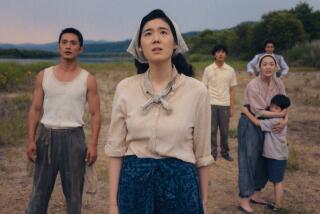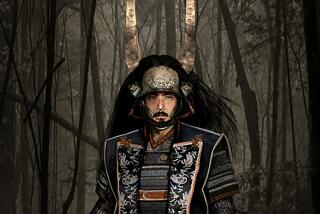TV REVIEW : Startling Beauty and Contrasts of PBS’ ‘Japan’
- Share via
It’s hard to decide which is more beautiful: Jane Seymour’s face or the stunning cinematography seen in “Japan,” the new PBS series she hosts (beginning tonight at 8 on Channel 50 and at 9 on Channel 15, and on Thursday at 9 p.m. on Channel 28).
Seymour, even when it sometimes seems that she’s on camera a little too often, is a most capable guide/narrator for this relentlessly artful and illuminating four-part study of Japan’s history, its culture and the unique East/West life style of its industrious people.
Though the camera fairly drools over Japan’s beauty, whether slowly panning a misty mountain or lingering on an ancient Shinto temple or exploring a perfect moss garden, there is nothing sluggish about this lavish production produced and directed by Peter Spry-Leverton for Chicago’s WTTW.
In the debut hour, “The Electronic Tribe,” the rice-farm origins of Japan’s famous cooperative factory system are explained, as well as the ways in which the famous Japanese character has been shaped less by the Shinto and Buddhist religions than by such strong family values as loyalty, obedience and hard work.
In addition to boss-worker relations at a Honda factory, we get a good look at the Japanese educational system (spartan school buildings with children themselves keeping the school clean) and a glimpse of the incredible headaches caused by Japan’s terribly pretty but terribly cumbersome alphabet.
We get a lovely lesson-in-the-nude on the etiquette of communal bathing, another on the proper way to bow to your superiors and another on the hierarchy of seating arrangements (the farther from the door you are the more important you are). A quiet tour of life in a hard-working 16-family farm community straight out of the 1750s is joltingly juxtaposed with scenes of gyrating urban teen-agers in black leather and boots who look like uniformed members of a cult that worships Sha Na Na.
Future installments--each equally loaded with interesting modern paradoxes and contrasts and spectacular images and haunting Japanese flute music and Seymour--examine such topics as Japan’s violent samurai spirit, its legacy from the shoguns, its rituals and its rise to economic superpowerdom.
“Japan” does address such national sore spots as Japan’s World War II brutalities (complete with graphic newsreel footage of the “Rape of Nanking”), a still-in-place caste system and the power of the criminal mafia. But it doesn’t exactly dwell on them.
If a general emphasis on the many positives (incredibly low crime rates, etc.) makes “Japan” seem more like a friendly travelogue than hard-edged documentary, so be it. It is an eye-opening and eye-pleasing substitute for those who can’t afford to fly over there on United Airlines, which just happens to have underwritten the series.
More to Read
The complete guide to home viewing
Get Screen Gab for everything about the TV shows and streaming movies everyone’s talking about.
You may occasionally receive promotional content from the Los Angeles Times.






